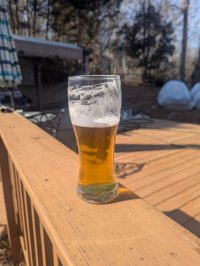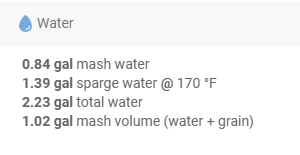Over the last year I did well over 40 batches - and improved my efficiency a lot. I began focusing on all grain batches and had much to learn.
But overall - how did the brew day go?
A + = you did every little thing perfectly. Mash temps were spot on. PH, and expected ABV - yes! Perfect!
A- = really great day. Followed all the small steps with military precision. Rock solid. Gonna be great beer. Mission accomplished.
B+ = okay there were some issues - nothing critical, just not by the "book". Some troubles, but did fine. Very good beer expected. Could be excellent.
B- = not a sh*t show by any stretch, but dang - I have much to learn. That's okay, expecting very good beer.
C = not a disaster but dang it - I screwed up. Nothing catastrophic but oh dear. Let's hope that never happens again. Should be good beer. Well shall see.
D = I got about 33% of the Don't Do That thread covered. Stuck mash, overflowing kettle, sprung leaks, rained hard, the dog caught a poisonous snake... I was making a 11g batch and got 6.5 g. out of it. Still made good beer. But dang.
F - had to dump it. Euthanize it. No one should ever taste that. The horror!
Here are my grades for 2024 sample of 40+ brew days.
A+ ...... 0%
A- ....... 25%
B+ ....... 45%
B - = ..... 10%
C = ...... 12.5%
D = ...... 5%
F = ....... 2.5%
So, a great year... Getting better. My goal this year is to get more A's. And get the C brew days below 5%.
Nothing better than a brew day that is as slick as warm butter. Curious to see what other homebrewers think about their brew day performance.
But overall - how did the brew day go?
A + = you did every little thing perfectly. Mash temps were spot on. PH, and expected ABV - yes! Perfect!
A- = really great day. Followed all the small steps with military precision. Rock solid. Gonna be great beer. Mission accomplished.
B+ = okay there were some issues - nothing critical, just not by the "book". Some troubles, but did fine. Very good beer expected. Could be excellent.
B- = not a sh*t show by any stretch, but dang - I have much to learn. That's okay, expecting very good beer.
C = not a disaster but dang it - I screwed up. Nothing catastrophic but oh dear. Let's hope that never happens again. Should be good beer. Well shall see.
D = I got about 33% of the Don't Do That thread covered. Stuck mash, overflowing kettle, sprung leaks, rained hard, the dog caught a poisonous snake... I was making a 11g batch and got 6.5 g. out of it. Still made good beer. But dang.
F - had to dump it. Euthanize it. No one should ever taste that. The horror!
Here are my grades for 2024 sample of 40+ brew days.
A+ ...... 0%
A- ....... 25%
B+ ....... 45%
B - = ..... 10%
C = ...... 12.5%
D = ...... 5%
F = ....... 2.5%
So, a great year... Getting better. My goal this year is to get more A's. And get the C brew days below 5%.
Nothing better than a brew day that is as slick as warm butter. Curious to see what other homebrewers think about their brew day performance.


![Craft A Brew - Safale S-04 Dry Yeast - Fermentis - English Ale Dry Yeast - For English and American Ales and Hard Apple Ciders - Ingredients for Home Brewing - Beer Making Supplies - [1 Pack]](https://m.media-amazon.com/images/I/41fVGNh6JfL._SL500_.jpg)

























































